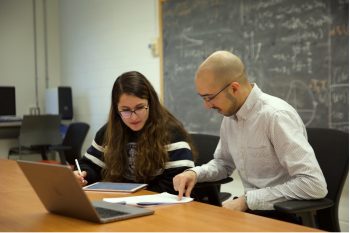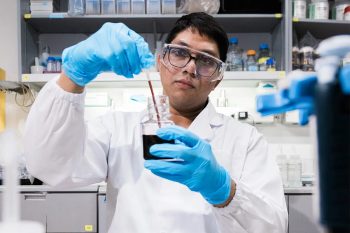Last fall, eight engineering students from U of T crowded around a small leaf-blower engine and argued whether it could power the world’s most fuel-efficient vehicle. Then, they tossed it aside and started building a better one from scratch.
Now – after their professors said it was impossible – that engine is at the heart of a new eco-car that’s headed this week to the Shell Eco-marathon in Houston, TX. Built by the U of T Supermileage team, the vehicle will compete against other high school and university groups in a worldwide challenge for fuel efficiency.
“They called us crazy. I can’t tell you how many professors said it wouldn’t be possible [to create a new engine], considering we only had eight months and a limited budget,” said Jonathan Hamway (MechE 1T3 + PEY), co-president of this year’s U of T team. “If nothing else, that was a bigger motivator for us: we just wanted to prove them wrong.”
Jonathan and the Supermileage team also competed in last year’s Eco-marathon. They didn’t win, but their vehicle travelled 266 kilometres on a single litre of fuel, making it 25 times more efficient than the average Canadian car. In this year’s competition, they aim to travel even farther on less fuel, while bringing a new world record to U of T.
According to Jonathan, they were the only group in North America this year to redesign their engine from the ground up – a task attempted with the help of George Brown student Ryan Billinger and U of T student Nikita Singarayar (MIE 1T3 + PEY), who worked on it as part of a Capstone Design project.
 The Supermileage engine, which is unlike any other of its size, won first prize among mechanical engineering capstone projects.
The Supermileage engine, which is unlike any other of its size, won first prize among mechanical engineering capstone projects.
“The number one thing we looked at is keeping as much heat in the chamber as possible,” explained Jonathan. “Some engines lose up to 70 per cent of their combustion energy as heat loss through the walls and as exhaust gasses.”
The team combatted the issue of heat loss by finding ways to convert the heat into usable energy, which massively increased the efficiency of the engine and makes it a huge contender in Houston.
In addition to building the motor, this year’s team also redesigned the vehicle body. They replaced last year’s heavy aluminum components with a streamlined, carbon fibre structure. This made the vehicle much lighter, while maintaining strength.
Jonathan said the diversity of his team was the reason they achieved the seemingly impossible: “We all come from different backgrounds, not just academically, but personally, and our experiences in life and in school all come together and complement each other.
“We’ve all been exposed to different things: it’s not just whoever’s in charge in electrical is only doing electrical; we all almost do everything, so that allows for a spread of knowledge. Everybody gets a chance to learn and be part of the team.”
The Supermileage team will compete head-to-head with other teams from across Canada, the United States, Mexico, Brazil, Chile and Guatemala. You can follow the competition on Twitter with the hashtag #SEM2014.
The 2014 team consists of co-presidents Jonathan Hamway (MechE 1T3 + PEY) and Mengqi Wang (ElecE 1T3), as well as Mayukh Chakraborty (MechE 1T3 + PEY), Pooya Tolideh (MechE 1T4), Pranav Kadhiresan (MSE 1T3 + PEY), Jacob Shultis (CompE 1T3 + PEY), Monica Lee (MechE 1T4 + PEY), Ryan Pan (MEng 1T7), Ashmith Raju (Mech 1T6), Prashanth Murali (MechE 1T3 + PEY), Kristine Confalone (ChemE 1T6) and Marcus Tan (ElecE 1T7).



